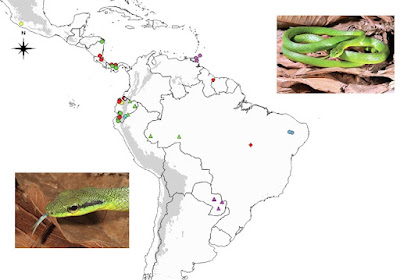[Most Recent Entries] [Calendar View]
Sunday, August 1st, 2021
| Time | Event | ||||
| 10:20a | [Herpetology • 2021] Leptophis • Molecular Phylogeny of Neotropical Parrot Snakes (Serpentes: Colubridae) supports underestimated Species Richness
Highlights: • We infer the largest phylogeny of Leptophis to date. • Widespread Leptophis ahaetulla sensu lato is composed of multiple species. • Species within L. ahaetulla have evolved distinct color patterns. • Widespread L. depressirostris possibly contains two species. Abstract Tetrapod taxa with broad geographic distributions across the Neotropics are often composed of multiple evolutionary lineages. In this paper, we present the most complete phylogeny of Leptophis to date and assess morphology-based species limits within the broadly distributed green parrot snake Leptophis ahaetulla sensu lato, which occurs from Mexico to Argentina. Although L. ahaetulla sensu stricto, L. nigromarginatus and L. occidentalis were recovered as paraphyletic, tree topology tests failed to reject their monophyly. Monophyly of L. bocourti, L. coeruleodorsus, L. cupreus, L. depressirostris, L. marginatus, L. riveti and L. sp. nov. was strongly supported. Our phylogenetic trees support recognition of multiple species within Leptophis ahaetulla sensu lato and suggest that color evolution and the uplift of the Andes played an important role in the diversification of parrot snakes. Keywords: Biodiversity, Neotropics, Snakes, Systematics, Tree-topology tests
Omar Torres-Carvajal and Claudia Terán. 2021. Molecular Phylogeny of Neotropical Parrot Snakes (Serpentes: Colubrinae: Leptophis) supports underestimated Species Richness. Molecular Phylogenetics and Evolution. 164, 107267. DOI: 10.1016/j.ympev.2021.107267 | ||||
| 10:22a | [Herpetology • 2021] Leptophis spp. • Molecular Phylogeny of Neotropical Parrot Snakes (Serpentes: Colubridae) supports underestimated Species Richness
Highlights: • We infer the largest phylogeny of Leptophis to date. • Widespread Leptophis ahaetulla sensu lato is composed of multiple species. • Species within L. ahaetulla have evolved distinct color patterns. • Widespread L. depressirostris possibly contains two species. Abstract Tetrapod taxa with broad geographic distributions across the Neotropics are often composed of multiple evolutionary lineages. In this paper, we present the most complete phylogeny of Leptophis to date and assess morphology-based species limits within the broadly distributed green parrot snake Leptophis ahaetulla sensu lato, which occurs from Mexico to Argentina. Although L. ahaetulla sensu stricto, L. nigromarginatus and L. occidentalis were recovered as paraphyletic, tree topology tests failed to reject their monophyly. Monophyly of L. bocourti, L. coeruleodorsus, L. cupreus, L. depressirostris, L. marginatus, L. riveti and L. sp. nov. was strongly supported. Our phylogenetic trees support recognition of multiple species within Leptophis ahaetulla sensu lato and suggest that color evolution and the uplift of the Andes played an important role in the diversification of parrot snakes. Keywords: Biodiversity, Neotropics, Snakes, Systematics, Tree-topology tests
Omar Torres-Carvajal and Claudia Terán. 2021. Molecular Phylogeny of Neotropical Parrot Snakes (Serpentes: Colubrinae: Leptophis) supports underestimated Species Richness. Molecular Phylogenetics and Evolution. 164, 107267. DOI: 10.1016/j.ympev.2021.107267 |
| << Previous Day |
2021/08/01 [Calendar] |
Next Day >> |




